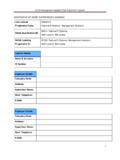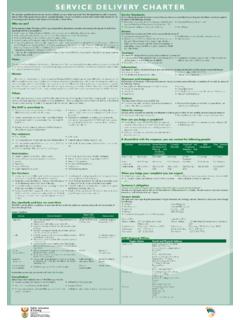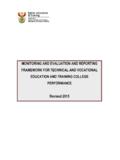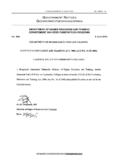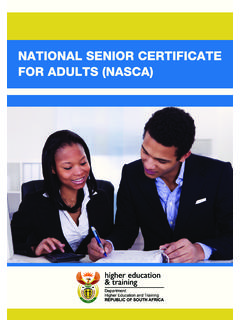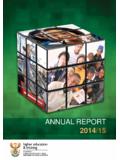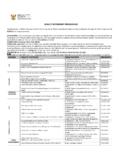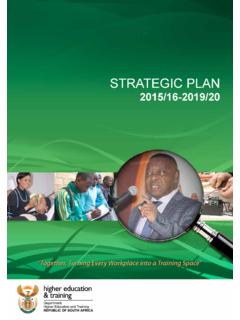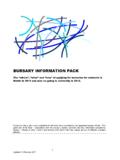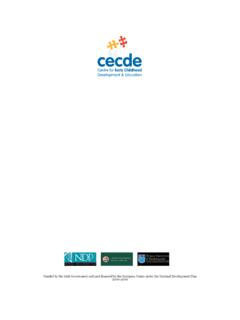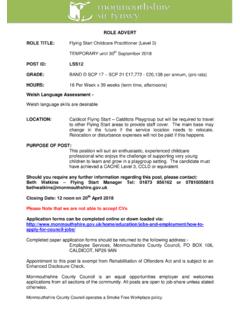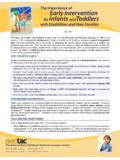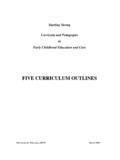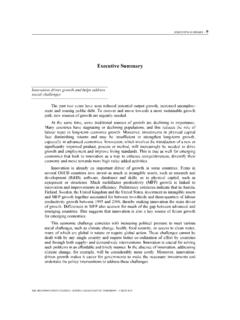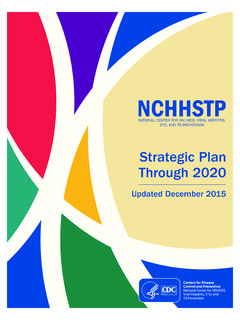Transcription of A Nation at Work for a Better Life for All
1 A Nation at Workfor aBetter life for AllHuman ResourceDevelopment Strategy for South Africa2 CONTENTSF oreword by the Ministers of Education and LabourThe Case for a Human Resource Development StrategySouth Africa today: Where do we stand?The HRD Strategy- Overview- Management, Governance and SupportStrategic Objectives:Strategic Objective OneImproving the foundations for human developmentStrategic Objective TwoImproving the supply of skillsStrategic Objective ThreeIncreasing employer participation in lifelong learningStrategic Objective FourSupporting employment growth through innovation and researchStrategic Objective FiveEnsuring that the four strategic objectives are linkedMonitoring Twenty-Two IndicatorsStrategic Objective One: Improving the foundations for human developmentIndicator One: Early Childhood DevelopmentIndicator Two: ABET and LiteracyIndicator Three: General EducationIndicator Four.
2 Examination pass ratesIndicator Five: Maths and Science resultsStrategic Objective Two: Improving the supply of high-quality skills (particularly scarceskills) which are more responsive to societal and economic needsIndicator Six: Learning in scarce skills areasIndicator Seven: Participation of adults in FETI ndicator Eight: Enrolments in HEIndicator Nine: Distribution of learners across HEIndicator Ten: Distribution of learners across FET and HEIndicator Eleven: Migration of scarce skillsIndicator Twelve: Placement of FET and HE graduatesPage456101013151516161818212122 22232526262628282930313 Strategic Objective Three: Increasing employer participation in lifelong learningIndicator Thirteen: Changes in the labour market structureIndicator Fourteen: Private sector responsiveness to new skillsIndicator Fifteen: Unemployment levelsIndicator Sixteen: Youth unemployment levelsIndicator Seventeen: Public sector skills developmentIndicator Eighteen: Skills development for SMME sIndicator Nineteen: Social development initiativesStrategic Objective Four: Supporting employment growth through industrial policies,innovation, research and developmentIndicator Twenty: Expenditure on research and development in SAIndicator Twenty-One: Science - Industry partnershipsIndicator Twenty-Two.
3 Identification of emergent economic sectorsStrategic Objective Five: Ensuring that the four strategic objectives of the HRD systemare linkedData managementIntegrationConclusionSource documentsPage323235383940414343434445464 64646474 FOREWORD BY THE MINISTERS OF EDUCATION AND LABOURWe are pleased to present to the public this Human Resource Development Strategy, whichwas approved by Cabinet earlier this year and which the President announced in his State ofthe Nation address in strategy has its origins in the Reconstruction and Development Programme (RDP), whichdeclared as one of the key principles that: Our people, with their aspirations and collective determination, are our most important resources.
4 The RDP is focused on our people s most immediate needs, and it relies, in turn, on their energies to drive the process of meeting these needs. Development is notabout the delivery of goods to a passive citizenry. It is about active involvement and growing empowerment. Following from this statement, the development of our human resources is identified as one ofthe five key programmes of the Human Resource Development strategy is innovative, and attempts to ensure that wemeet the needs of our economy and our democratic order. It is a signal of our determination asGovernment to give practical effect to this commitment of the RDP. In terms of the strategy ourpeople will be provided with a solid educational foundation for social participation, and also beempowered to develop relevant and marketable skills at further and higher education levels.
5 Atthe same time employers will contribute to the identification and development of skills for theeconomy, and Government will promote and support policies which target employment growthin key industrial strategy will be underpinned by a set of institutional arrangements, including SectorEducation and Training Authorities, and the reshaping of Further and Higher Education. Thesewill ensure that the necessary co-ordination between the pillars of the strategy is achieved. TheHuman Sciences Research Council will support the monitoring of progress on the identified indicators,and this will enable us to report regularly to the Cabinet on the development of our humanresources, and the impact of this on our overarching goals of the strategy are ambitious, including an improvement in the HumanDevelopment Index for South Africa, a reduction in inequality, and a higher position on theinternational competitiveness table.
6 We believe these are all possible, and are committed toworking together, and with our Cabinet colleagues, to ensure that we create an enablinghuman resource development environment to make our Nation work , and to enjoy a Better life . Professor Kader MdladlanaMinister of EducationMinister of Labour5 THE CASE FOR A HUMAN RESOURCE DEVELOPMENT STRATEGYP resident Thabo Mbeki has spelt out a vision for South Africa as a Nation at work for a betterlife for all. The purpose of this Human Resources Development (HRD) Strategy is to provide aplan to ensure that people are equipped to participate fully in society, to be able to find or cre-ate work , and to benefit fairly from it. The organising principle which has been used to cohere the various components of this strate-gy is the concept of work .
7 This is not a narrow understanding of work , and must be under-stood as being the full range of activities that underpin human dignity by achieving self-suffi-ciency, freedom from hunger and poverty, self-expression and full citizenship. Nationshood andproductive citizenship are inter-dependent, and it is in this sense that we speak of a Nation atwork for a Better life for is common cause that there is an enormous amount to be done to end poverty and to pro-mote growth in the economy. Since 1994, over 1 million houses have been built, clean waterhas been supplied to million people, and nearly 400 000 electricity connections were madein 2000 alone. And yet there is no shortage of work still to be done - houses, schools and clin-ics to be built, roads to be provided, telecommunication systems to be put in place, children tobe given good quality education.
8 The list is long. A more robust social and physical infrastruc-ture is needed, not only to ensure that the basic needs of our people are met, but also toenable them to work in ways that bring returns and increase the quality of their reasons are put forward to explain why in our society unemployment and poverty persistwhen there is still so much to be achieved. Not all of the reasons have to do with the capabili-ties of people; many have to do with the unequal distribution of productive assets in our socie-ty. The poor have very few resources to muster; indeed many have only their own labour touse or sell. But the capabilities of people nevertheless remain a limiting factor in the attainmentof socio-economic development, and this stratergy seeks to address the problem in a system-atic way.
9 At the heart of the proposed HRD strategy is the belief that enhancing the generaland specific abilities of all citizens is a necessary response to our current situation, whichshould be embedded within the overall economic, employment and social development pro-grammes of the State. To realise their potential citizens need knowledge, skills and democraticvalues, and they also need opportunities in which to apply them. There are South Africanswho have skilled labour to sell - and they cannot find buyers because there are not enoughjobs, their skills do not match the demands, and there is no systematic process for informationto flow between government, the workplace and labour.
10 The government s HRD strategy has two roles to play in this environment. One is to ensurethat the various components of the state work together in a co-ordinated way to deliver oppor-tunities for human development. The second is to ensure that those people who have sufferedfrom discrimination in the past are put at the front of the queue in terms of the identified Nation -al priorities. South Africa s constitution states that Everyone has inherent dignity and the rightto have their dignity respected and protected. Dignity is therefore an inalienable right, but inpractice it is linked to a range of other factors - cultural, social, and economic. Citizens who livein poverty and without opportunities to develop their natural potential have their dignityimpaired.
